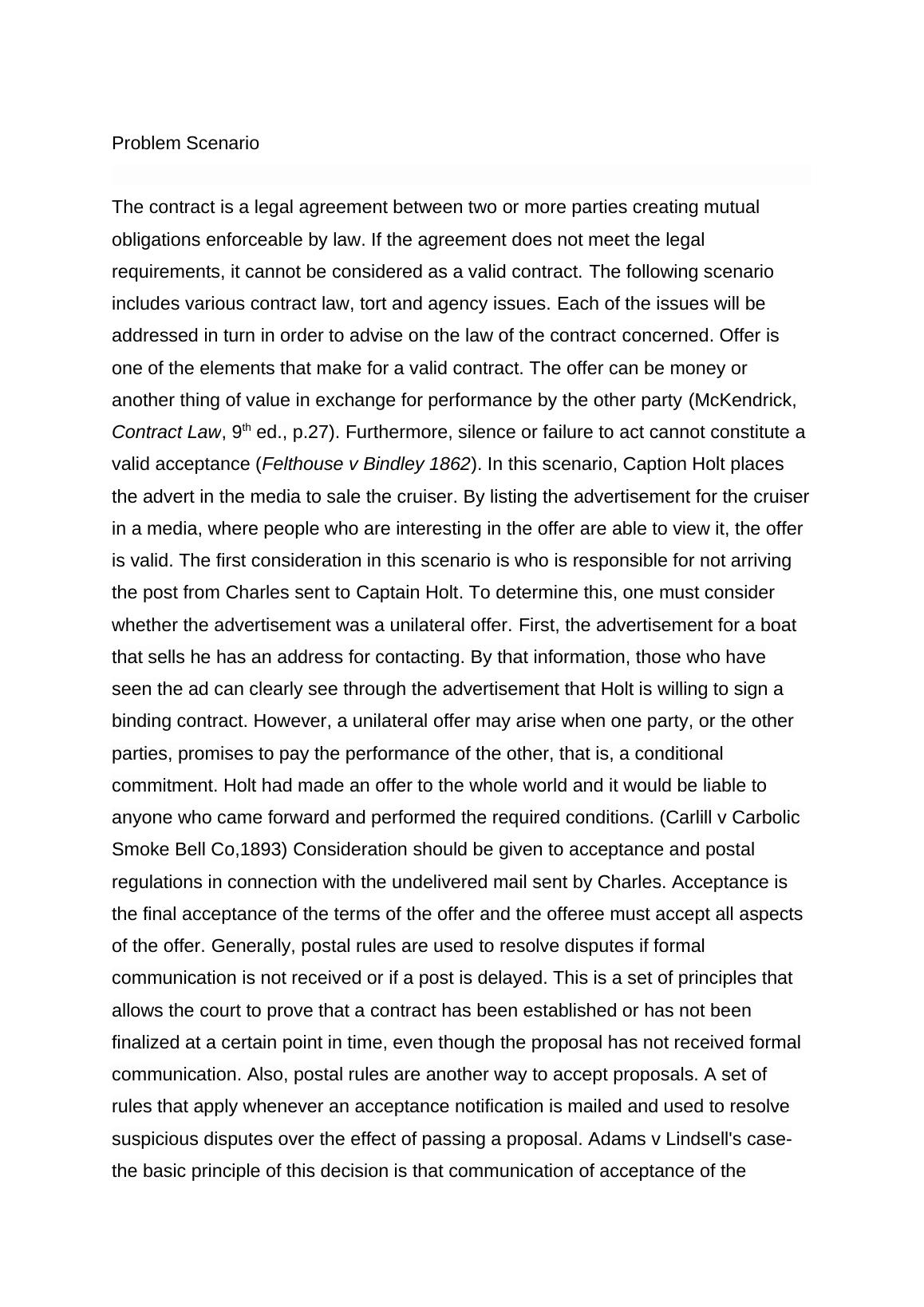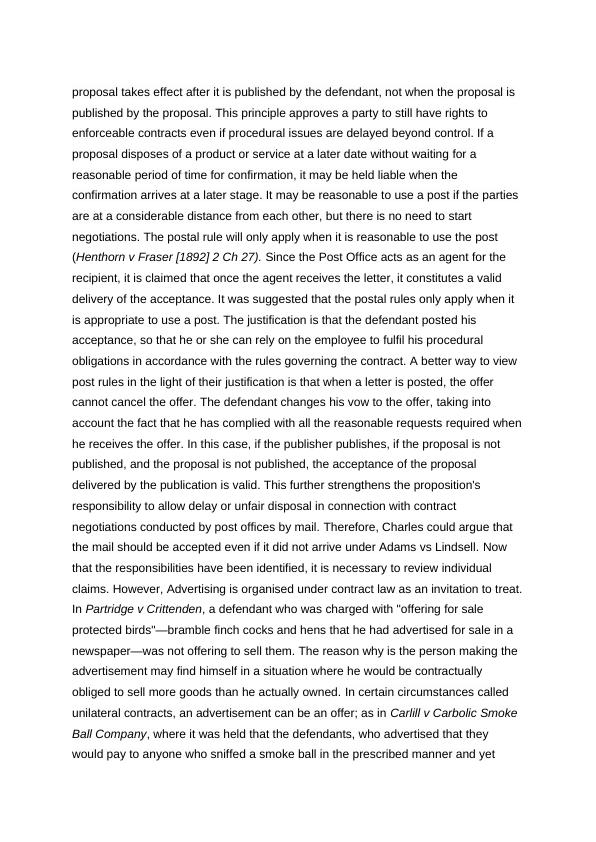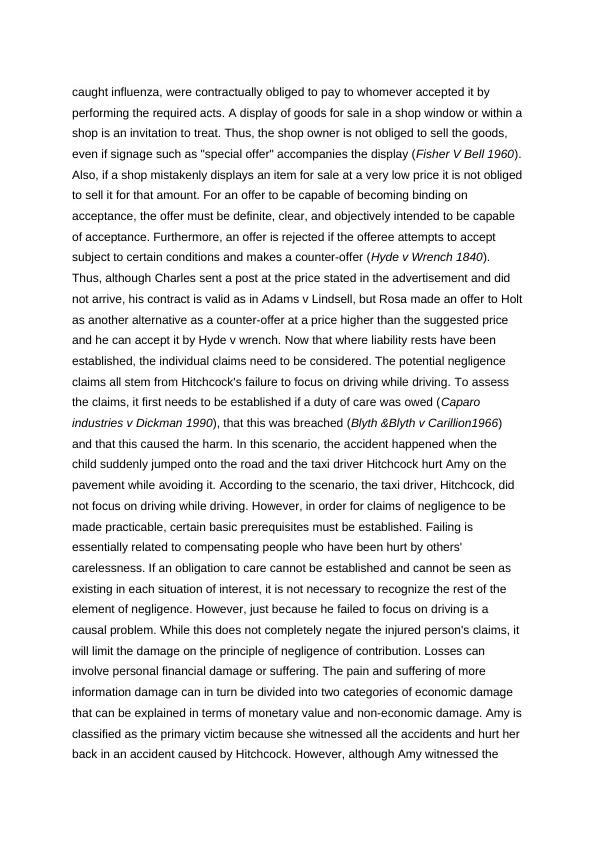Introduction to Contract law : Assignment
Added on 2021-04-27
6 Pages2162 Words106 Views
Problem ScenarioThe contract is a legal agreement between two or more parties creating mutual obligations enforceable by law. If the agreement does not meet the legal requirements, it cannot be considered as a valid contract. The following scenario includes various contract law, tort and agency issues. Each of the issues will be addressed in turn in order to advise on the law of the contract concerned. Offer is one of the elements that make for a valid contract. The offer can be money or another thing of value in exchange for performance by the other party (McKendrick, Contract Law, 9th ed., p.27). Furthermore, silence or failure to act cannot constitute a valid acceptance (Felthouse v Bindley 1862). In this scenario, Caption Holt places the advert in the media to sale the cruiser. By listing the advertisement for the cruiserin a media, where people who are interesting in the offer are able to view it, the offer is valid. The first consideration in this scenario is who is responsible for not arriving the post from Charles sent to Captain Holt. To determine this, one must consider whether the advertisement was a unilateral offer. First, the advertisement for a boat that sells he has an address for contacting. By that information, those who have seen the ad can clearly see through the advertisement that Holt is willing to sign a binding contract. However, a unilateral offer may arise when one party, or the other parties, promises to pay the performance of the other, that is, a conditional commitment. Holt had made an offer to the whole world and it would be liable to anyone who came forward and performed the required conditions. (Carlill v Carbolic Smoke Bell Co,1893) Consideration should be given to acceptance and postal regulations in connection with the undelivered mail sent by Charles. Acceptance is the final acceptance of the terms of the offer and the offeree must accept all aspects of the offer. Generally, postal rules are used to resolve disputes if formal communication is not received or if a post is delayed. This is a set of principles that allows the court to prove that a contract has been established or has not been finalized at a certain point in time, even though the proposal has not received formal communication. Also, postal rules are another way to accept proposals. A set of rules that apply whenever an acceptance notification is mailed and used to resolve suspicious disputes over the effect of passing a proposal. Adams v Lindsell's case-the basic principle of this decision is that communication of acceptance of the

proposal takes effect after it is published by the defendant, not when the proposal is published by the proposal. This principle approves a party to still have rights to enforceable contracts even if procedural issues are delayed beyond control. If a proposal disposes of a product or service at a later date without waiting for a reasonable period of time for confirmation, it may be held liable when the confirmation arrives at a later stage. It may be reasonable to use a post if the parties are at a considerable distance from each other, but there is no need to start negotiations. The postal rule will only apply when it is reasonable to use the post (Henthorn v Fraser [1892] 2 Ch 27). Since the Post Office acts as an agent for the recipient, it is claimed that once the agent receives the letter, it constitutes a valid delivery of the acceptance. It was suggested that the postal rules only apply when it is appropriate to use a post. The justification is that the defendant posted his acceptance, so that he or she can rely on the employee to fulfil his procedural obligations in accordance with the rules governing the contract. A better way to view post rules in the light of their justification is that when a letter is posted, the offer cannot cancel the offer. The defendant changes his vow to the offer, taking into account the fact that he has complied with all the reasonable requests required whenhe receives the offer. In this case, if the publisher publishes, if the proposal is not published, and the proposal is not published, the acceptance of the proposal delivered by the publication is valid. This further strengthens the proposition's responsibility to allow delay or unfair disposal in connection with contract negotiations conducted by post offices by mail. Therefore, Charles could argue that the mail should be accepted even if it did not arrive under Adams vs Lindsell. Now that the responsibilities have been identified, it is necessary to review individual claims. However, Advertising is organised under contract law as an invitation to treat.In Partridge v Crittenden, a defendant who was charged with "offering for sale protected birds"—bramble finch cocks and hens that he had advertised for sale in a newspaper—was not offering to sell them. The reason why is the person making the advertisement may find himself in a situation where he would be contractually obliged to sell more goods than he actually owned. In certain circumstances called unilateral contracts, an advertisement can be an offer; as in Carlill v Carbolic Smoke Ball Company, where it was held that the defendants, who advertised that they would pay to anyone who sniffed a smoke ball in the prescribed manner and yet

caught influenza, were contractually obliged to pay to whomever accepted it by performing the required acts. A display of goods for sale in a shop window or within ashop is an invitation to treat. Thus, the shop owner is not obliged to sell the goods, even if signage such as "special offer" accompanies the display (Fisher V Bell 1960).Also, if a shop mistakenly displays an item for sale at a very low price it is not obligedto sell it for that amount. For an offer to be capable of becoming binding on acceptance, the offer must be definite, clear, and objectively intended to be capable of acceptance. Furthermore, an offer is rejected if the offeree attempts to accept subject to certain conditions and makes a counter-offer (Hyde v Wrench 1840). Thus, although Charles sent a post at the price stated in the advertisement and did not arrive, his contract is valid as in Adams v Lindsell, but Rosa made an offer to Holtas another alternative as a counter-offer at a price higher than the suggested price and he can accept it by Hyde v wrench. Now that where liability rests have been established, the individual claims need to be considered. The potential negligence claims all stem from Hitchcock's failure to focus on driving while driving. To assess the claims, it first needs to be established if a duty of care was owed (Caparo industries v Dickman 1990), that this was breached (Blyth &Blyth v Carillion1966) and that this caused the harm. In this scenario, the accident happened when the child suddenly jumped onto the road and the taxi driver Hitchcock hurt Amy on the pavement while avoiding it. According to the scenario, the taxi driver, Hitchcock, did not focus on driving while driving. However, in order for claims of negligence to be made practicable, certain basic prerequisites must be established. Failing is essentially related to compensating people who have been hurt by others' carelessness. If an obligation to care cannot be established and cannot be seen as existing in each situation of interest, it is not necessary to recognize the rest of the element of negligence. However, just because he failed to focus on driving is a causal problem. While this does not completely negate the injured person's claims, it will limit the damage on the principle of negligence of contribution. Losses can involve personal financial damage or suffering. The pain and suffering of more information damage can in turn be divided into two categories of economic damage that can be explained in terms of monetary value and non-economic damage. Amy isclassified as the primary victim because she witnessed all the accidents and hurt herback in an accident caused by Hitchcock. However, although Amy witnessed the

End of preview
Want to access all the pages? Upload your documents or become a member.
Related Documents
Evaluation of Contractual Agreements among Partieslg...
|6
|1274
|491
Contract Law Application 2022lg...
|8
|1878
|25
Application of Postal Rule in Business & Contract Legal Studieslg...
|8
|2319
|345
Business and Corporations Lawlg...
|5
|1306
|284
Introduction to The Commercial Lawlg...
|9
|2643
|14
Contract and Commercial Law Assignmentlg...
|10
|2608
|32
